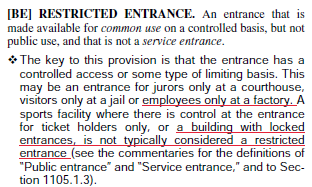Sifu
SAWHORSE
- Joined
- Sep 3, 2011
- Messages
- 3,388
The code and commentary indicate a door that is for common use on a controlled basis, but not for public use is a restricted entrance. Commentary goes on to say that the key provision here is that the door must have controlled access to meet the definition, and further that a simple locked entrance door does not.
So I have an office suite, in a very large F1. The office suite is proposing to add an exterior door during a remodel. The existing suite had no door, but for the life of me I can't see where the accessible route to it was, unless it was over 500' long, through the factory floor, across the storage warehouse but that's another story. Now they want to add a non-accessible door. They do not provide "controlled access" as far as I can tell, though I need more information about that. The problem is the notion that all of the office staff can enter via this door (it is noted as having the sidewalk extended from the existing parking lot) but a disabled person can't, and that is ok because there is no key-fob (controlled access). Not sure that makes sense.
So I have an office suite, in a very large F1. The office suite is proposing to add an exterior door during a remodel. The existing suite had no door, but for the life of me I can't see where the accessible route to it was, unless it was over 500' long, through the factory floor, across the storage warehouse but that's another story. Now they want to add a non-accessible door. They do not provide "controlled access" as far as I can tell, though I need more information about that. The problem is the notion that all of the office staff can enter via this door (it is noted as having the sidewalk extended from the existing parking lot) but a disabled person can't, and that is ok because there is no key-fob (controlled access). Not sure that makes sense.

